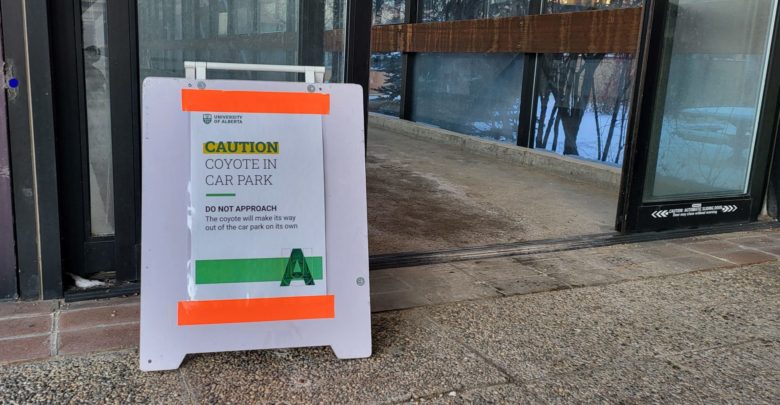Ask a Prof: Why would a coyote go into Stadium Car Park?
Colleen St. Clair, a coyote-human interactions expert discusses the recent alert about a coyote in Stadium Car Park.
 Arthur Macatangay
Arthur MacatangayAn alert email was sent out to the University of Alberta community December 8 warning that there was a coyote in Stadium Car Park.
The message said that University of Alberta Protective Services (UAPS) was trying to lead the coyote out of the parkade. An update was later issued that based on recommendations from Alberta Fish and Wildlife, UAPS would leave the coyote alone, and the animal would “eventually make its way out of the car park.”
In a comment provided by the university, it was confirmed that “the coyote left the Stadium car park last night, without any incidents.”
“The alert was intended to quickly notify and keep members of our community safe and minimize the risk of an unfortunate encounter.”
The Gateway sat down with Colleen St. Clair, a professor in the department of biological sciences, to discuss why a coyote might end up in a parkade and potential risks that might be associated. St. Clair is also the principle investigator in The Edmonton Urban Coyote Project, which researches coyote behaviour in an effort to reduce negative coyote-human interactions.
Responses have been edited for brevity and clarity.
Q: Why would a coyote go into a parkade?
There’s two reasons it might do that. One would be to seek shelter, and the other one would be seek food.
Q: Would a coyote pose any risk to students and staff?
There was a risk, but it’s very low. Not absent, though.
Coyotes have been documented, attacking people, usually children, but occasionally adults. When that occurs, usually it’s associated with the defence of young pups in a den nearby, which obviously isn’t the case here.
Animals that go into that kind of proximity to people at this time of year are usually not dominant animals, they’re usually kind of desperate animals. Those animals don’t tend to be highly aggressive. So I think in this instance, the risk to people was very, very low.
Nonetheless, it’s alarming to people usually to find themselves in close proximity to a coyote, and especially in a place that’s completely designated for human uses, like a parkade.
Q: The alert that went out yesterday said that UAPS was trying to “lead him out of the car park,” but in an update said that Alberta Fish and Wildlife “recommended leaving the coyote alone.” What are the pros and cons of those two strategies?
Well, I think probably the better action would have been to just let the animal leave on its own. There would be nothing in the parking garage that would be expected to attract it in an ongoing way — it was likely exploratory.
But I can see why the officers chose to act the way they did. They might have thought that was a risk to either people or the coyote from being run over. For example, if it sought shelter under a recently parked vehicle, that could be quite a dangerous situation.
Sometimes coyotes end up in places like that, because they are trying to escape the aggression of other coyotes.
I don’t think the coyote would choose to stay in a parking garage for very long. There doesn’t tend to be resources there for them. So I can see the logic of both approaches.
Q: How can this sort of situation be prevented?
What I recommend for coyotes in any residential area is to treat them as aggressively as possible, whenever that’s possible. That’s a technique known as hazing. And we’ve just completed a study where we trained volunteers and neighborhoods throughout Edmonton to haze coyotes on site, if coyotes allowed them to approach within 40 meters in residential areas during the day.
The purpose of hazing is to keep coyotes from becoming comfortable close to people. When they start to associate people with food, they lose all fear of people, that motivation for food just overtakes their natural fear of people. And that can become quite dangerous.
So that’s why I recommend hazing in residential areas to keep coyotes wary around people, and prevent that sequence of events that leads to conflict, and ultimately, typically with the destruction of the coyotes.
Q: What does this say about the bigger picture of the coyote population in Edmonton?
I don’t think it says too much. Coyotes have been on campus lots of times. And probably they’ve been in all of our parking garages — just not detected by people. They would be more likely to do that at night than during the day.
There are lots of examples from across the continent of coyotes in very unexpected locations. My favorite example is a coyote on a subway seat in Seattle. I think it is just curled up looking kind of comfortable. There are examples of coyotes entering all kinds of human use areas. And that’s been increasing cross the continent in urban areas. So this particular incident is part of that trend, but I wouldn’t say it’s especially remarkable.



